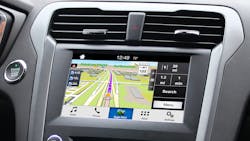Survey: Paying for advanced vehicle systems a sticking point
A new global survey by research firm IHS Markit of 5,000 vehicle owners in five countries -- the U.S., Canada, China, Germany and the United Kingdom (U.K.) – finds that while they “desire” more advanced technologies, such as telematics, in-car wireless network or “Wi-Fi” capability, and navigation systems, few seem willing to pay significantly extra to obtain them.
According to IHS Markit forecasts, by 2022, significant volumes of new vehicles will be equipped with telematics: in the U.S., 87%; in Germany, 91%; in the U.K, 92%; in Canada, 89%; and in China, 54%. The firm also believes more than half of the global fleet of vehicles in operation will be “connected” ones as well.
In comparison, 32% of all consumers polled by IHS Markit agreed that telematics would be a feature they would be willing to pay for in their next new vehicle, with in-car wireless something only 29% would pay for.
However, when asked about cost, both of those technologies were mentioned with a much lower price point by consumers willing to pay for them and different price points that varied by region:
- U.S. price premium for telematics/wireless: $484 to $472 extra
- Canada: $168 to $181 extra
- Germany: $402 to $322 extra
- China: $294 to $226 extra
- U.K.: $386 to $345 extra
Roadside assistance, crash notification and navigation systems are top of mind for consumers, IHS Markit determined in its survey, with more than half of all respondents indicated they already have at least one vehicle that features an infotainment or navigation system that offers such as roadside assistance, stolen vehicle assistance, crash notification or turn-by-turn navigation.
Those features garnered the most interest for future vehicles as well, across all geographies, the firm found, with 32% of respondents globally indicating that roadside assistance is the most important telematics feature in a new vehicle, with stolen vehicle assistance important to 28% of respondents.
Automatic crash notification and turn-by-turn navigation were both preferred by one quarter of respondents. In addition, the inclusion of real-time traffic information was overwhelmingly preferred by 51% of total respondents, with dynamic routing and a desire for maps to be updated wirelessly based on current conditions preferred by 41% for routing and 36% for wireless updates respectively.
As in-vehicle technology continues its growth trajectory, so too does consumer desire to integrate their mobile apps into their vehicle. Among those surveyed, nearly all consumers who had familiarity with replicating their smartphone system onto an in-vehicle display indicated they were interested or somewhat interested in having this feature in their next new vehicle.
In addition, nearly half of all respondents indicated navigation apps as the leading use of smartphone apps in the vehicle. Weather apps followed with 40% of respondents using them in the vehicle, and 36% of respondents use music apps while in their vehicle, IHS Markit found.
About the Author
Fleet Owner Staff
Our Editorial Team
Kevin Jones, Editorial Director, Commercial Vehicle Group
Cristina Commendatore, Executive Editor
Scott Achelpohl, Managing Editor
Josh Fisher, Senior Editor
Catharine Conway, Digital Editor
Eric Van Egeren, Art Director
